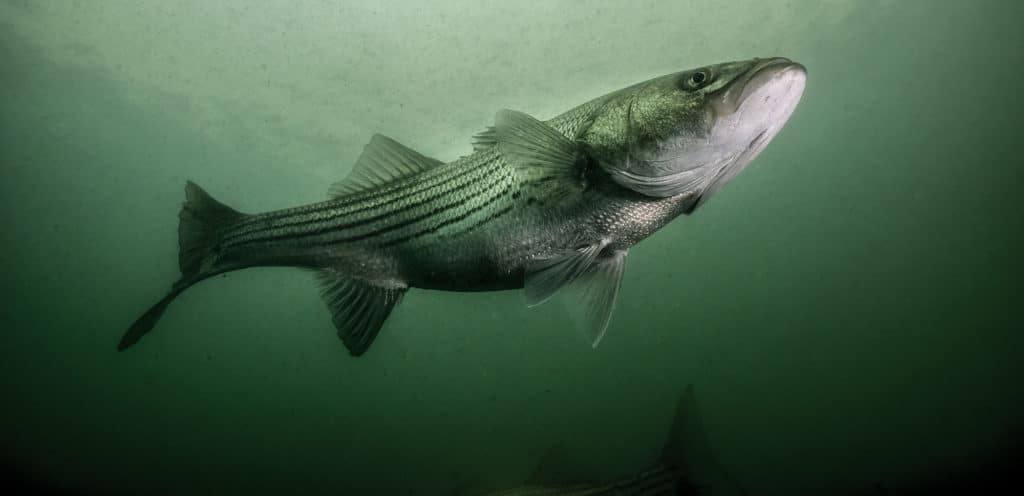
“This one felt different,” my friend Chris Duva told me. Duva and his buddies had already caught several good-size striped bass that summer evening off Rhode Island, but then he hooked into something a little different: “This one peeled line off the reel much more easily than the others.”
The captain tried to position the boat directly over the fish, Duva related. But the fish had other ideas. The drag sang as the relatively light braid disappeared into dark waters.
“I didn’t want to lose this fish because I just knew I had my personal-best striper on the other end,” he continued. “I tried to stay focused as I fought the fish but worried about the jagged rocks and sharp ledges below.”
Finally, after a stressful 15 minutes, Duva saw a flash below, illuminated by the boat’s T-top lights. “I inched the fish closer to the surface, and the captain finally lunged and netted my biggest striper ever. The fish hit the deck, and we all stared at this beautiful mid-40-pounder. That’s why we come to Block Island!”
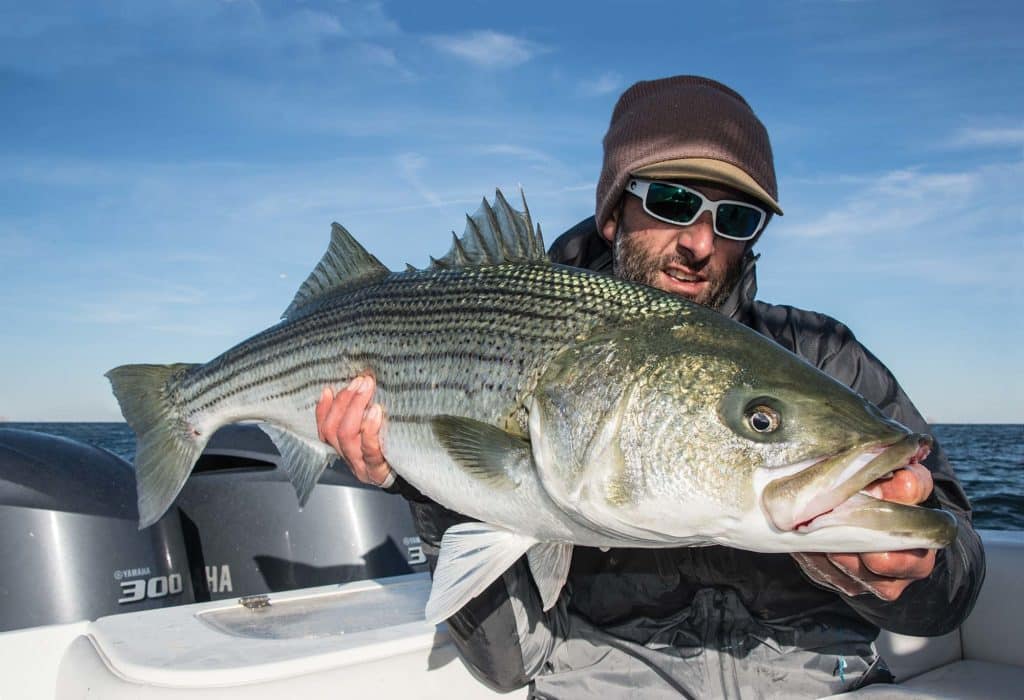
Striped Bass Mecca
Popular with tourists, and accessible only by boat, 10-square-mile Block Island sits 12 miles south of the Rhode Island port of Point Judith. It’s also very accessible from Montauk, New York, requiring only a 14-mile run north and west to reach the island. Summer is usually the time most anglers head to Block Island, but fall can be just as productive. In fact, we’ve caught fish as late as October.
Block has always been a great striped bass destination, but over the past seven or eight years, fishing for huge trophy bass has exploded. Science-based theories suggest that multiple robust year classes have contributed to this success; several fish over 60 pounds are caught in Block’s waters each year.
When I was a kid growing up and fishing the waters of New England with my dad, I read about many legendary striped bass locations in the pages of fishing magazines and dreamed about visiting those spots one day. They included: Plum Island and Cuttyhunk, Massachusetts; Race Point at Cape Cod; Montauk; the Hudson River; and the Chesapeake Bay.
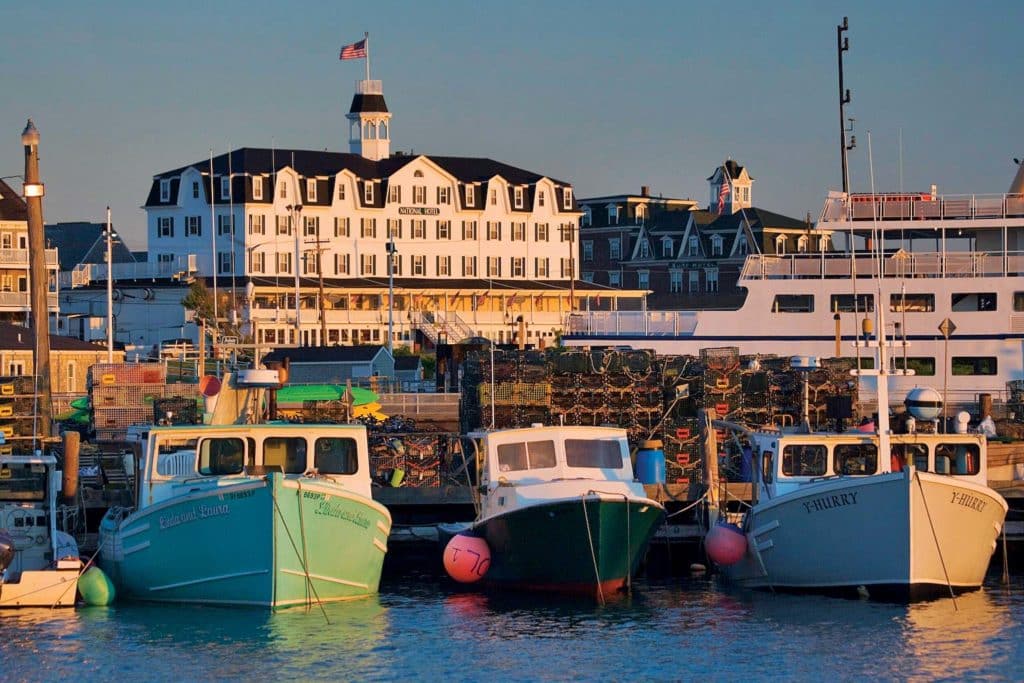
Block Island recently joined that list of elite destinations. Block is one of the few places on the planet where an angler not only can potentially surpass the revered 50-pound mark, but also have a legitimate shot at landing a world record. However, catching a fish of this enormous stature is never easy, no matter where and how you fish for them.
Block holds two favored hot spots for anglers. On the north side, the well-known North Reef extends from the island toward Rhode Island’s mainland. This sandy shoal produces great rips at the peak of the incoming and outgoing tides where fish can ambush bait. The surrounding depth changes from 70 feet to 30 feet, and then up to 13 feet. Good numbers of fish can be caught by drifting eels or squid-imitating artificials, and sometimes even by vertical-jigging big irons.
Slammer bluefish also move into these rips in July, and jump-start some fantastic topwater action and bottomfishing. Also, North Reef — and all of Block Island — lies a mere 40 miles from the location in Long Island Sound where Greg Myerson caught the current all-tackle world-record striper of 81-plus pounds in 2011.
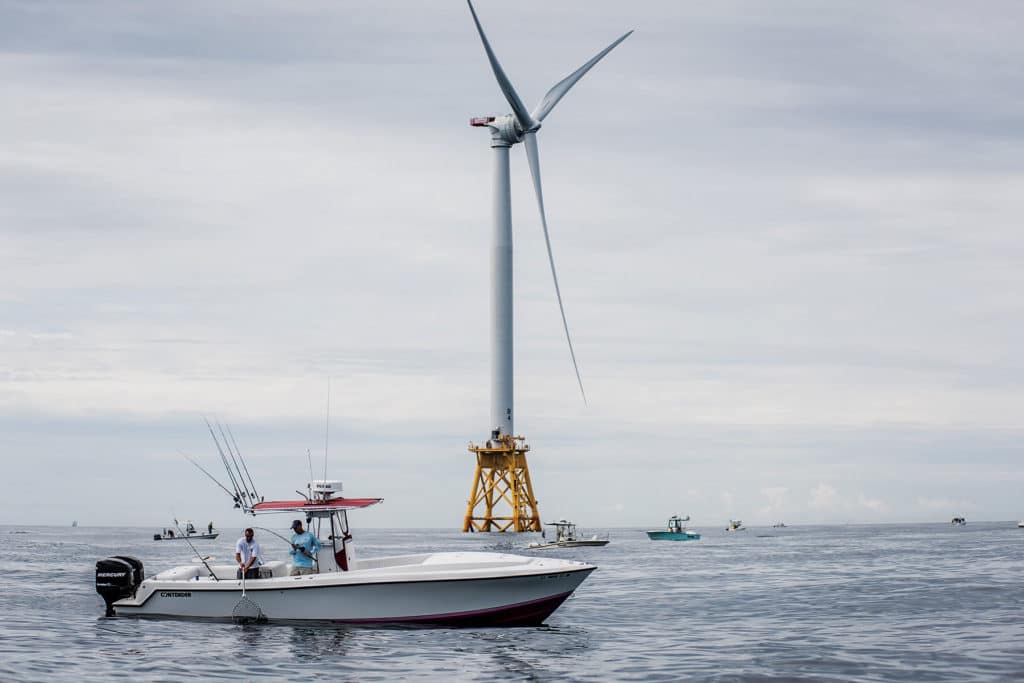
On the other end of the island sits the renowned Southwest Ledge. A first glance at your chart plotter simply shows the Southwest Ledge as an area somewhat shallower than its surrounding waters. However, depths outside the ledge drop to about 70 feet, jumping up to about 35 feet on the ledge. When anglers fish there for the first time, they’re shocked to find fast-moving currents, confused waves and often-giant swells. This is not an area for small boats or the weak of heart.
On the bottom lie jagged ledges, rocky areas and big boulders — all perfect habitat for ambush-feeding stripers, and all prime for wreaking havoc upon fishermen and their tackle. If the stripers cooperate and feed at the surface during daylight hours, fishing can be fast, furious and amazing. Unfortunately, that’s rarely the case. Most of the time, the bigger fish hang out in their rocky living rooms and lazily wait for dinner to flow to them in the swift currents.

Method to Madness
The captains who consistently catch fish over 30 or 40 pounds at the Southwest Ledge try to position their boats directly over productive ledges and boulder fields so the lines work straight up and down. When a fish hits, the angler can fight the fish vertically and not be handicapped by a lot of scope that can drag over the barnacle-encrusted rocks.
A typical tackle setup would include a 5000- to 8000-size spinning reel, medium or medium-heavy 7-foot rod, 30-pound braid, and a 40-pound fluorocarbon leader with 1 to 3 ounces of weight and a 5/0 circle hook. But some successful anglers choose lighter 20-pound main line and 30-pound fluorocarbon leaders — much lighter than ever traditionally imagined for this type of fishing. I know one captain who uses only very light 15-pound braided line with no leader at all.
“There are a number of techniques used to target and land these large fish, ranging from trolling extra-large artificials [such as parachute jigs, umbrella rigs, tube lures and bunker spoons] on wire line to light-tackle drifting live or natural baits over specific structure,” says well-known Block Island charter captain Jack Sprengel. “The most successful captains and crews understand how to adapt their presentations to the specific and subtle influence that different phases of the tide can have on fish, forage and structure alike. They get very specific with details.”
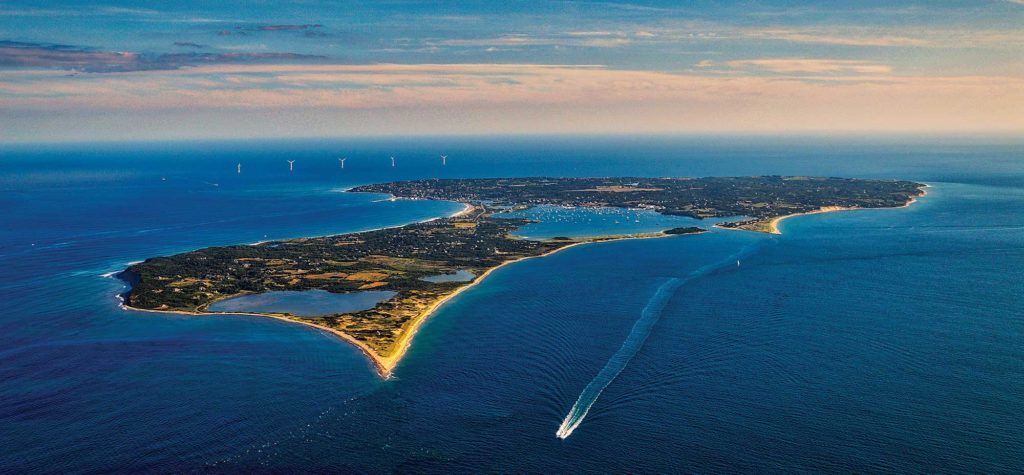
Some captains even switch from braid to mono to avoid higher-pitch harmonics in strong currents, Sprengel says. In some cases, anglers trim down to the lightest leaders, hooks and weights when large bass feed higher in the water column on smaller baits during the less-intense moon phases.
“The key factor in all methods, when targeting subsurface-holding stripers, is maintaining both a constant physical connection to your presentation and a mental understanding of where your bait is as it relates to the contour of the structure below,” Sprengel continues. “Being constantly aware of your presentation allows the angler to adjust to changes in the bottom like snags or drop-offs and to be prepared for the mixed bag of ‘takes’ a striped bass can offer.”
Sometimes, 50-plus-pound bass do little more than open their large bucket mouths, creating a vacuum that easily inhales the bait. The angler feels only a tap or light thump on the rod tip. “Other times we’ve seen a few dead-sticked rods in rod holders, fishing an eel from a properly positioned boat on the drift get smashed downward by fish in the mid-30- to low 40-pound class so hard that even some of the highest-quality rods explode.”
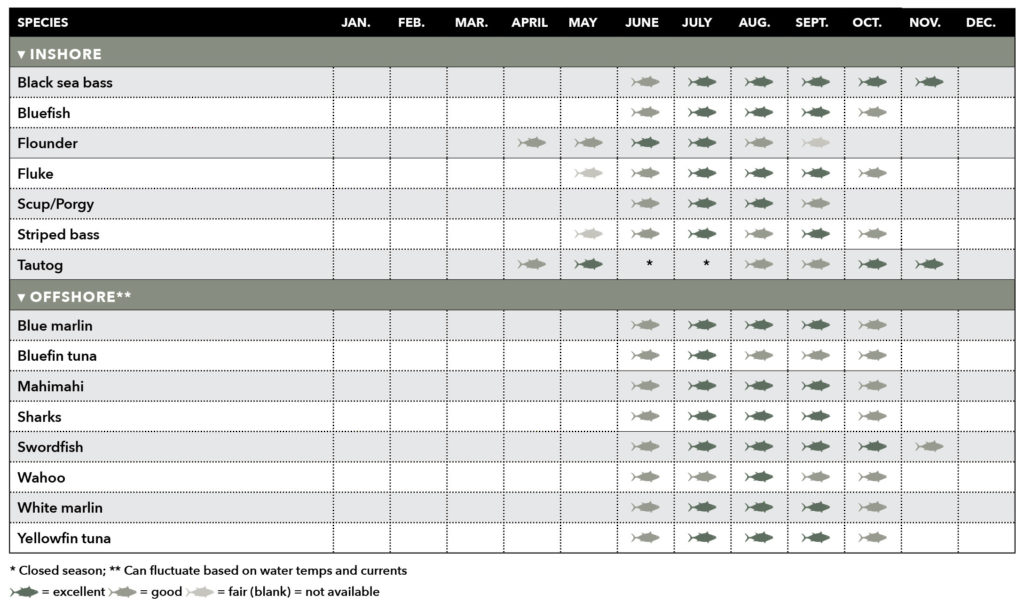
Regardless of the type of take, at some point during the fight, a striped bass engages in a blistering power run before settling in, hopefully straight below the boat. That run makes or breaks a catch, Sprengel says. Using its huge tail, large head and all of its shear body mass, “it makes a nerve-racking long run, often down-current, swimming up and over or down into any rocky snags or structure it can find. Trust me, this will fully test your tackle and your angling ability,” he says.
Proper boat handling, aggressive angling techniques and a fast-acting crew are key when one of these freight trains decides to head for the horizon.
Despite his 30 years of striped bass fishing experience, Sprengel says the species never ceases to amaze him. “Their ability to adapt to different sources of prey, water conditions and completely different bodies of water is second to no other species on the planet,” he says. “Just by traveling a hundred-or-so-mile stretch of shoreline in New England alone, you can target these fish using dozens of regionally specific techniques, each allowing for an entirely different perspective of this majestic game fish.”

While You’re There
Although not nearly as exciting to catch as big stripers, delicious black sea bass and scup (porgies) have shown up around Block Island in huge numbers and in huge dimensions. One morning when the striper bite shut down, I switched to medium-size conventional outfits spooled with 20-pound braid, and dropped down small vertical jigs and fluke squid rigs. We caught sea bass after sea bass and limited on fish in the 20-inch range.
Read Next: New Atlantic Striped Bass Fishing Techniques
Another advantage of Block Island’s location is its proximity to productive offshore fishing. Popular shark fishing locations lie about 20 to 30 miles from the island. The deeper waters of the offshore canyons — such as Block Canyon, Atlantis Canyon and others — lie about 95 miles offshore. These 1,600-plus-foot-deep canyons can produce epic catches of yellowfin tuna, mahimahi, white marlin and even swordfish during summer.
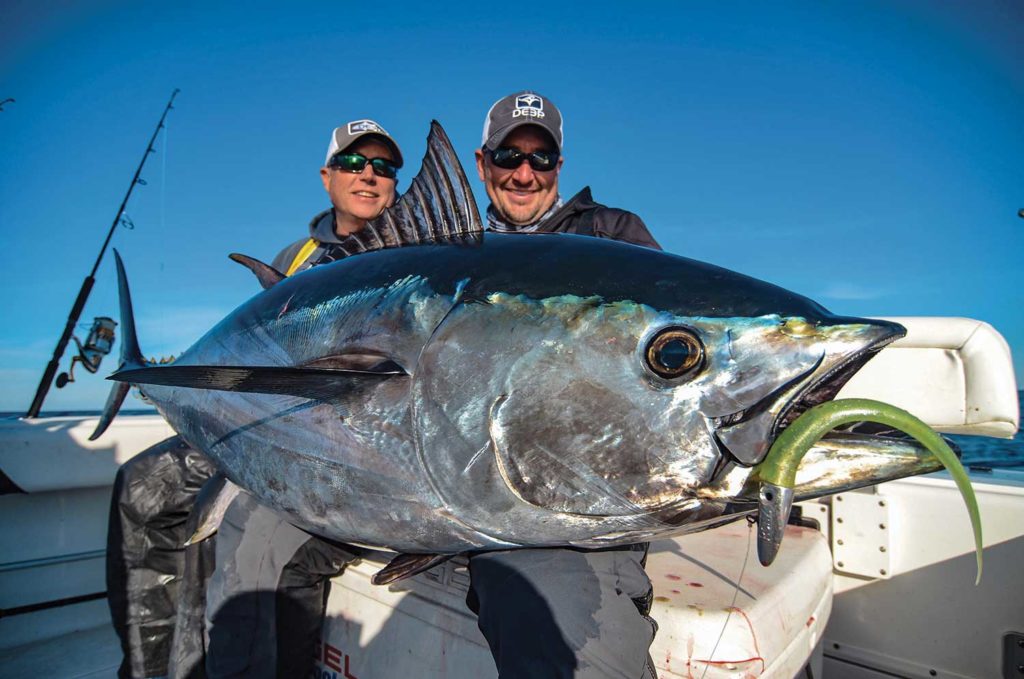
In addition to those pelagic species, bluefin tuna from 50 to 350 pounds migrate off Block Island in early summer. Popular spots include the Dump, the Gully, the Inside Fingers, Coxes and Gordon’s Gully — the closest of these lies about 20 miles off Block.
Depending on the time of year and presence of bait, bluefin can be caught on anything from trolled spreader bars to trolled ballyhoo. My all-time-favorite method is running-and-gunning to breaking fish using heavy spinning gear and poppers or soft plastics like Hogy baits and Ron Z baits. This type of fishing can be spectacular as fish explode from the depths to blow up on your offerings.

In my opinion, casting to big tuna, especially when they’re hitting topwater baits, trumps every other type of saltwater fishing. It tests your tackle, endurance and fishing skill, and can be the most rewarding way to fish.
Whether you target big stripers, giant tuna or tasty bottomfish, do yourself a favor and plan a bucket-list trip to Block Island this year. You might just make the catch of your lifetime.
About the Author Dave Morel is the publisher of Sport Fishing and Salt Water Sportsman, and an avid saltwater fisherman and enthusiast. He lives in Massachusetts and has been fishing since he took the training wheels off his bike.
Island Time
Narragansett Indians first settled Block Island, calling it Manisses, which translates to “island of the little god,” according to island tourism officials. Dutch explorer Adrian Block sailed to the island in the early 1600s and gave the place its current name.
Today, visitors can access Block Island by high-speed ferry. Passenger-only vessels leave from Point Judith and Newport, Rhode Island, and from Fall River, Massachusetts. If you want to cross with your car, you must leave out of Point Judith.
The island features two bait shops as well as two marinas that can accommodate boats: New Harbor, accessible on the western side of the island, and Old Harbor on the eastern side. New Harbor offers dockage and moorings, while Old Harbor is more of a ferry port with some mooring options and limited facilities. Both put you closer to the fishing action than leaving from the mainland.
Remember, when fishing Block Island, you must stay within a 3-mile zone of the island (in state waters) to legally fish for striped bass. The fishery for striped bass in federal waters has been closed since 1990. Law-enforcement boats patrol those waters on a regular basis.
Also, when the fishing heats up midsummer, boat traffic increases, particularly at the Southwest Ledge. On one particular September morning, I could have counted probably 300 boats fishing the ledge, but at night, traffic drops off significantly.
For more general information on Block, visit the Block Island Tourism website at blockislandinfo.com.
Block Island Captains
Big Game Sportfishing
(Point Judith)
401-243-7046
biggamefishingri.com
Newport Sport Fishing Charters
978-877-0997
nsfcharters.com
Jack Sprengel
East Coast Charters
401-338-1752
eastcoastchartersri.com
Christopher Willi
Block Island Fishworks
401-742-3992
sandypointco.com
Marinas
Block Island Old Harbor and New Harbor
blockislandinfo.com/harbors-and-boating
Point Judith Marina, Snug Harbor
pjmarina.com








